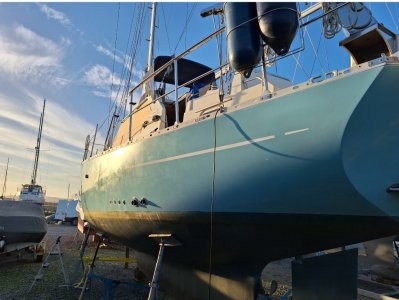Laminar Flow
Well-known member
This is how we did it with performance examples in the second half. Enjoy!
I would say that it is the SA/D ratio.Is the main difference between a 'sailing boat' and a 'motorboat with a mast' , the nut on the end of the tiller?
Sail area is one thing, ability to windward is another.I would say that it is the SA/D ratio.
A Motorsailer, according to Brewer, should have a SA/D ratio of between 13 and 14.
Ours, calculated over volume of displacement for saltwater is 17,98, or mid range cruiser/racer (17-19).
That is reflected in her performance.
Best, A.

I agree with this - getting the sail plan balanced for a given point of sailing and wind strength makes a big difference. You can hang on to full sail in strong winds but everything is much easier and barely slower with some main rolled in or mizzen dropped. Perhaps its part of the reason why a ketch rig is popular on these sort of boats.Just picking up on oldmanofthehills' comment re weather helm and centre of effort of sails. This concept of cof e of sails versus centre of lateral resistance of hull/keel does work nicely in conditions of gentle breeze and flat boat.
I think however that as soon as you heel the boat with a bit of strong breeze the non symetrical shape of the hull in the water and sail drive being to lee ward, causes weather helm effect that is much more powerful than any effect from sail pressure balance. Now the power of this weather helm from heeling does vary with boat shape but in the case of my little boat is very severe. Needs a large rudder to control. But mostly sail area reduction either jib or main. ol'will
Really interesting video, and you've done a great job in making a boat that suits you. I'm actually amazed that original rudder got signed off for production really!I forgot:
Much fuss, perhaps too much, is made of windward ability and at the cost of everything else, though the current crop of planing types seem to do much better downwind than their immediate forebears, albeit also at a sacrifice in windward excellence.
There are plenty of older boats going to the tip these days and I can't imagine it being overly difficult finding a longer spar at a reasonable cost.I suppose for many motorsailer owners, the limiting factor will be the cost of new spars and sails etc to follow OP’s lead. I would assume the cost of larger spars and rigging alone would be more than the value of the boat itself, and then a whole suite of sails is required. That said, as someone who sails a ‘non-deckhoused’ year round in the UK, I watched the vid with great envy!
My comment was based on the assessment and analysis by Eric Sponberg, who, himself, designed a few of these types (retired now, I think). If things have improved then, that is probably a good thing.Just to nit pick on one point - the most recent planing types are not really giving up windward performance. As discussed in several threads now, boats like the JPKs, Sunfasts, Class 40s etc, that are capable of getting up and boogying downwind were demonstrably faster to windward over the heavy airs beat to the fastnet rock last summer than their non planing predecessors.
And in more normal AWB land, the Sunsail skippers I know reported that, much to their surprise, their new "fat boy" Jeaneau 410s are demonstrably faster upwind than the First 40s that they replaced. In all except very light winds. They had a season of racing them together and apparently it was very quickly clear that the older boats were noticeably
Well, we've debated that point over lots of threads... So you have seen the race results before now...My comment was based on the assessment and analysis by Eric Sponberg, who, himself, designed a few of these types (retired now, I think). If things have improved then, that is probably a good thing.
The moment something like that becomes available with a heated wheelhouse, as well as the carrying capacity for near enough a 3/4 ton of fluids, provisions for 2-4 months of expedition cruising, all the mod coms of home, three anchors with gear and all rest of the usual and necessary cruising tackle, tools and bicycles, and, moreover, all in a close to 30' package, I promise to pay more attention.
Best, A.
A good point, and if a motorsailer was designed to sail well to begin with you shouldn't need to make radical changes. I think the Fisher 34 suffers (and benefits) from a very heavy displacement for its length, and its not especially beamy. Something like 4.8 tonnes of ballast, and 11.5 tonnes displacement! A lot of 37's have a bowsprit similar to yours presumably to up the sail area, and bring the centre of effort forward.Additionally, not every type is suitable for that kind of dramatic SA increase. Quite a few models have rather slack bilges and limited initial stability. I saw pictures of a Fisher 34 in NL that had been "pimped" with a much taller mast and which, consequently, seemed to be sailing at rather startling angles of heel.